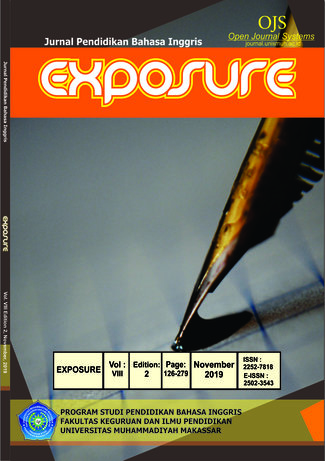ORAL CORRECTIVE FEEDBACK IN SPEAKING CLASS: ITS FREQUENCY, STUDENTS’ PERCEPTIONS AND PREFERENCE
DOI:
https://doi.org/10.26618/exposure.v8i2.2785Kata Kunci:
oral corrective feedbackAbstrak
The objective of this qualitative study is to investigate kinds of corrective feedback used by the English lecturer in speaking class at English Department in one of private University in Jember. Further, this research also investigate how the students’ perception and preference lying on their speaking proficiency toward the corrective feedback which is dominantly used by the lecturer. Based on the analysis taken from questionnaire given to 30 students of English Language Education department, it was found that (1) recast, repetition and clarification request are commonly used in the class. And (2) according to the students’ perceptions, repetition is the effective feedback that engage the students to improve their speaking skill. Last (3) the students prefer to get repetition and explicit correction as the feedback in the speaking class.
Referensi
Amalia, Z. D. H., Fauziati, E., & Marmanto, S. (2019). Male and female students’ uptake in responding to oral corrective feedback. Journal on English as a Foreign Language, 9(1), 107. https://doi.org/10.23971/jefl.v9i1.1047
Argüelles, L. G., Méndez, E. H., & Escudero, M. D. P. (2019). EFL teachers’ attitudes towards oral corrective feedback: A case study. Profile: Issues in Teachers’ Professional Development, 21(1), 107–120. https://doi.org/10.15446/profile.v21n1.69508
Askew, S. (2000). Feedback for Learning. New York: Taylor and Francis Group.
Atkinson, P., Coffey, A., & Delamont, S. (2001). Qualitative Research. 1(1), 5–21.
Chu, R. (2011). Effect of Teacher’s Corrective Feedback on Accuracy in The Oral English of English- Major College Students. Theory and Practice in Language Studies, 1(5), 455–459.
Cohen, L., Manion, L., & Morrison, K. (2000). Research Methods in Education (Fifth). London: Routledge Falmer.
Creswell, J. W. (2014). Qualitative, Quantitative and Mixed Method Research Design (Fourth). United States of America: Sage.
Ellis, R. (2009). Corrective Feedback and Teacher Development. Journal for Foreign and Second Language Educators.
Fan, N. (2019). An Investigation of Oral Corrective Feedback in an ESL Listening and Speaking Class. Journal of Language Teaching and Research, 10(1), 197. https://doi.org/10.17507/jltr.1001.22
Fonsec, J., Carvalho, C., Conboy, J., Valente, M., & Gama, A. (2015). Changing Teacher Teachers’ Feedback Practices: A Workshop Challenge. Australian Journal Teacher Education, 40(8).
Gattalo, F. (2000). Formative Assessment in ELT primary (Elementary) Classroom: An Italian Case Study. Language Testing, 17(2), 278–288.
Harmer, J. (1998). How To Teach English. London: Wesley Longman Limited.
Hattie, J. ., & Timperley, H. (2007). The Power of Feedback. Review of Educational Research, (77), 81–112.
Heigham, J., & Croker, R. A. (2009). Qualitative Research in Applied Linguistics; A Practical Introduction. New York: Palgrave Macmillan.
Hornby, A. (2010). Oxford Advanced Learners’ Dictionary. Oxford: University Press Ltd.
K.Yin, R. (2016). Qualitative Research from Start to Finish (Second). New York: The Guilford Press.
Kamiya, N. (2018). An analysis of the meaning of “natural” concerning oral corrective feedback. Tesl-Ej, 22(1), 1–13.
Lightbown, P., & Spada, N. (2004). How Language Are Learned (Second Edi). New York: Oxford University Press.
Lyster, R, & Ranta, L. (1997). Corrective Feedback and Learner Uptake: Negotiation of Form in Communicative Classrooms. Studied in Second Langauge Acquisition, 19, 37–66.
Lyster, Roy, Saito, K., & Sato, M. (2013). Oral Corrective Feedback in Second Langauge Classroom. Jounal Cambridge Language Teaching, 46(1), 1–40.
Neals. (2015). Types of Feedback. State of Newsouth Wales: Department of Education and Communities.
Spiller, D. (2009). Assessment: Feedback to Promote Student Learning. Teaching Development.
Wiggins, G. (2002). Assessment as Feedback. New Horizons For Learning.
Unduhan
Diterbitkan
Terbitan
Bagian
Lisensi
Authors who publish with this journal agree to the following terms:
In order to assure the highest standards for published articles, a peer review policy is applied. In pursue of the compliance with academic standards, all parties involved in the publishing process (the authors, the editors and the editorial board and the reviewers) agree to meet the responsibilities stated below in accordance to the Journal publication ethics and malpractice statement.
Duties of Authors:
- The author(s) warrant that the submitted article is an original work, which has not been previously published, and that they have obtained an agreement from any co-author(s) prior to the manuscript’s submission;
- The author(s) should not submit articles describing essentially the same research to more than one journal;
- The authors(s) make certain that the manuscript meets the terms of the Manuscript Submission Guideline regarding appropriate academic citation and that no copyright infringement occurs;
- The authors(s) should inform the editors about any conflict of interests and report any errors they subsequently, discover in their manuscript.
Duties of Editors and the Editorial Board:
- The editors, together with the editorial board, are responsible for deciding upon the publication or rejection of the submitted manuscripts based only on their originality, significance, and relevance to the domains of the journal;
- The editors evaluate the manuscripts compliance with academic criteria, the domains of the journal and the guidelines;
- The editors must at all times respect the confidentiality of any information pertaining to the submitted manuscripts;
- The editors assign the review of each manuscript to two reviewers chosen according to their domains of expertise. The editors must take into account any conflict of interest reported by the authors and the reviewers.
- The editors must ensure that the comments and recommendations of the reviewers are sent to the author(s) in due time and that the manuscripts are returned to the editors, who take the final decision to publish them or not.
Authors are permitted and encouraged to post online a pre-publication manuscript (but not the Publisher’s final formatted PDF version of the Work) in institutional repositories or on their Websites prior to and during the submission process, as it can lead to productive exchanges, as well as earlier and greater citation of published work (see The Effect of Open Access). Any such posting made before acceptance and publication of the Work shall be updated upon publication to include a reference to the Publisher-assigned DOI (Digital Object Identifier) and a link to the online abstract for the final published Work in the Journal.

